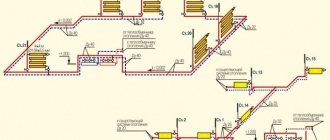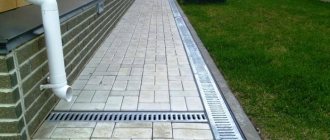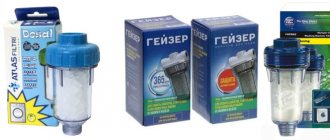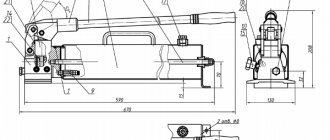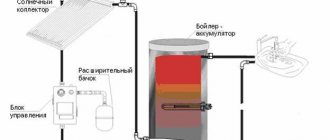Photo: installation of protective hatches
Convenient is that for the operation of such cesspools there is no need to equip a ventilation outlet. Gas formation is minimized due to the absence of large accumulations of feces. At the same time, a certain part of the wastewater and gases always goes into the ground. This feature solves two problems at once: reducing the volume of runoff due to gas and the presence of an unpleasant odor in the area.
Video: finished cesspool with overflow https://www.youtube.com/watch?v=tddX0DlE844
Caring for a cesspool with overflows is also not difficult. Cleaning with sewer machines is carried out as necessary. On average, no more than once every six months. Every month you need to check the filters for contamination and siltation. If you use bacterial cleaning, it is recommended to update biological filters every 2 weeks.
Cesspool with overflow: design features, operating principles and diagrams
The problem of waste disposal in a private suburban area has long been solved with the help of an ordinary cesspool, which is a storage tank. The structure has to be constantly pumped out and there is no escape from the unpleasant smell. To solve the problem, it is better to use a more modern independent treatment facility - a cesspool with an overflow. The design is capable of processing large amounts of liquid waste. These are wastewater from shower stalls, dishwashers, washing machines, bathtubs, and appliances used to improve comfort. Therefore, it is necessary to consider the device, operating principle and possible options for an improved sump. This will allow you to avoid the issue of constructing a treatment plant on private territory that is not connected to a centralized sewerage system.
Ventilation
The installation of a ventilation system for the treatment plant is one of the key works. This is due to the performance of the following tasks by such a system:
- preventing the spread of unpleasant odors from wells and mains;
- protection against rarefaction of air in sewer pipes.
The technology for constructing this system comes down to connecting the waste pipe of the treatment plant to the ventilation riser, which is discharged onto the roof of the building. In this case, it is necessary to ensure that the riser pipe has at least the same diameter as the pipe with which the septic tank is connected to the facility’s sewer system. The most suitable value for the diameter of the waste pipe is 110 mm.
If the selected cross-section is small, then as a result of water drainage, the pipe lumen will be blocked. A piston effect will occur, due to which liquid will be sucked from the siphons of plumbing fixtures, against which the principle of the water seal will stop working. The most unpleasant thing here will be that odors from the sewer will begin to spread into the room.
Design and principle of operation of a cesspool with an overflow well
Installation of a treatment plant with an overflow is carried out for the effective disposal of sewage generated as a result of human activity. The degree of processing allows part of the wastewater to be discharged into the soil, onto filtration fields, and used for watering plants.
Sump design with overflow well
A drainage pit with an overflow of simple design is a two-chamber treatment facility. A sewer pipe is used to connect the compartments. The first tank is made in the form of a large container with a sealed bottom and walls. This is a receiver where sewage from a private house enters through a polyvinyl chloride sewer pipe with a diameter of 110 mm. It is laid in the ground.
The second container has the same design as a sewer well with a filter bottom. The lower part of the tank is not a monolithic structure. Liquid can leak through it. It is a filter with a minimum thickness of 1 m. Slag, crushed stone, sand, and gravel are used as the filter element.
An overflow well is an absorption structure. The walls of the container can be solid or have holes. The second option allows you to increase the speed of removal of treated sewage.
The two tanks are connected by a PVC sewer pipe located at an angle. It allows sewage to flow naturally from the receiver into the absorption well. The depth of pipe installation is influenced by the climatic conditions of the area. It should be located below the freezing point of the soil. The diameter of the connecting pipeline is usually 50-110 mm, and its length is determined by territorial features.
A ceiling equipped with a hatch is installed above the drainage pit. Both tanks of the treatment plant are covered with lids. Hatches allow you to monitor the operation of the device and carry out repairs. This design also facilitates pumping out sewage.
The treatment plant is equipped with ventilation. The air duct in the form of a pipe is installed above the level of the drains. It must always be above the sewage horizon, regardless of the degree of filling of the tank. Often the ventilation pipe is installed only in the filter well. However, it is recommended to install ventilation in each compartment of a simple wastewater treatment facility.
Operating principle of a sump tank with overflow well
The installation of a cesspool with overflow in a private countryside area, including summer cottages, allows you to process sewage more efficiently and in less time compared to a conventional waste tank. The operating principle of a septic tank in the form of a sump with an overflow well is quite simple. Sewage from the house first enters the first sealed compartment. In it, wastewater accumulates and settles. This is where heavy particles settle. They have the appearance of silty deposits. Solids are periodically removed from the tank. The sediment can be used by the homeowner during composting.
As waste accumulates, the liquid level in the receiving container rises. After reaching the overflow pipe, sewage flows into another tank without a sealed bottom. The settled wastewater enters the second container already partially purified, for example, by bacteriological microorganisms. The post-treatment process of liquid sewage mass is carried out in the absorption well. It passes through a filter layer at the bottom of the tank. It is the placed bulk materials that additionally purify sewage.
Note! On private property, a drainage pit with an overflow well with a sealed bottom can be constructed. In this case, the second tank is also a settling tank. The sewage is re-settled in the container. They can also be cleaned by bacteria, which feed on biowaste and organic matter. If aerobic microorganisms are used, then the treatment plant must be equipped with a ventilation duct or aerator. After this, the wastewater flows into the infiltrator or onto the filtration field.
When organizing a septic tank in the form of a cesspool, grease traps and filter meshes are often installed. The elements are installed on the overflow pipe. They retain some of the dirt when the sewage mass moves between containers.
How to make shambo
After determining the installation location of the shambo in accordance with sanitary standards, the structure is installed. Let's consider the most commonly used installation option of reinforced concrete rings.
Scope of work:
- Development of a pit with a depth of 3 m, overall dimensions along the width of the rings with a reserve for the installation of subsequent waterproofing. Most often, rings with diameters of 100 or 200 cm are used. If the required volume is insufficient, two rows of rings can be laid. When you connect the two resulting columns with an overflow tube, you get a kind of chambeau septic tank.
- After carefully leveling the bottom of the pit, a 10 cm sand cushion is placed. After compacting the sand, the first ring with the bottom is laid. If this is not available, a layer of reinforced concrete is laid and the junction of the lower ring adjacent to the concrete is insulated to prevent drainage from seeping into the soil.
- Installing the bottom ring using a truck crane. It is recommended to select rings with existing grooves and a ridge, which ensures a tighter connection.
- The next ring is installed on the bottom ring on a layer of cement mortar with the addition of liquid glass. If there are no grooves, the connection is additionally fixed using metal plates or brackets. The installation of the remaining rings is carried out similarly.
- Insertion of a supply pipe into the well with sealing of the entry.
- Waterproofing the resulting well outside and inside.
- Backfilling a septic tank.
- The last ring can be purchased with a factory-made cover, which has a hatch with a plastic or cast iron cover. If such a ring has not been purchased, then the reinforced concrete cover with a hatch is mounted on a regular cement-sand mortar.
- Installation of ventilation pipe.
- Insulation of the lid.
After completing the work, you can begin testing the system and its further operation.
- Engineering Communication
Advantages and disadvantages of a cesspool with an overflow well
Almost all designs have pros and cons. An overflow septic tank is no exception. The positive and negative aspects of the treatment plant will help you make the right decision regarding the need to construct the structure.
Advantages of a waste overflow pit
The main advantage of a septic tank with an overflow is the less frequent calls for a sewage truck to pump out sewage. Wastewater that has undergone a purification process in a cesspool is often used for technical purposes. They are suitable for watering crops in dachas, washing paths and other structural elements in private areas.
Additional advantages of a waste pit with an overflow well are the following:
- Good performance, since the minimum volume of treatment facilities of this type is 2 m3. The cesspool has a throughput capacity of 0.2 to 0.5 m 3 per hour. If necessary, you can always increase the number of containers, which will increase the performance of the septic tank.
- Cost savings during the operation of the structure, since special equipment has to be ordered less frequently due to the same multi-stage sewage treatment. Solid elements of wastewater are filtered out already in the first tank, and the liquid medium moves further. Therefore, the formation of solidified masses and overflow of the treatment plant is eliminated. Moreover, part of the wastewater is absorbed by the soil, and a certain amount is simply dumped into the ground.
- Almost complete absence of unpleasant odor. It will completely disappear if special microorganisms are used to process sewage.
Not bad cleaning efficiency, because the waste treatment process consists of several stages depending on the number of containers. Increasing the number of tanks makes it possible to improve the quality of processing and the safety of wastewater for nature.
Conventional cesspools make unpleasant popping sounds when overfilled. Designs with overflow do not have this drawback. This allows you not to monitor the amount of waste. You can use water and not worry that the treatment plant will overflow.
Disadvantages of a sewage overflow pit
The disadvantages of a treatment plant with an overflow well include the complexity of installation. The homeowner needs to accurately calculate the angle at which the pipe needs to be laid to and between the tanks. You will also need to calculate the location of the tanks relative to each other. Another disadvantage is the high cost of installation compared to a conventional cesspool, since it is necessary to construct at least 2 independent wells.
Septic tanks of our own production
Quite often, a cesspool is built with one’s own hands for a summer residence, as well as for a private house. The strength of this rather complex system is the ability to carry out deep waste treatment. At the same time, they are processed into fertilizer, which is then used to enrich the soil. The complex most often consists of two or three chambers. The first of them is intended for liquid accumulation and primary mechanical cleaning. After this, special bacteria come into play, which leads to complete recycling of hazardous waste.
Using the overflow principle in constructing a drainage pit in a private home allows you to achieve outstanding results. The water inside the system is purified so well that in the future it can be used for economic and technical purposes - watering the garden, washing surfaces and cleaning areas. Arranging a drainage pit with an overflow will require considerable financial and physical costs. Old car tires are often used for this (the main thing is that they do not have holes). Given the light weight of the rubber, the construction of a solid foundation in this case is not required. Usually a compacted cushion of crushed stone and sand 30-40 cm thick and a cement screed 10 cm high are installed.
Recommendations on how to equip a cesspool from homemade septic tanks:
- A good way to increase the volume of a tank constructed from tires is to cut off their sidewalls.
- A concrete pipe is installed inside the finished tire trunk in a strictly vertical position. A building level is used for this. It is desirable that it be 2 times smaller in diameter than the tire size.
- The pipe is mounted so that its upper cut is 10 cm below the mouth of the rubber well.
- Concrete is used to fill the bottom of the pipe. As a result, you need to get a monolithic concrete cylinder. It is equipped with a hole at the top for infiltration and for an overflow pipe.
- The sewer pipe is inserted into the container. Areas where the vertical and sewer pipes are connected to each other must be sealed.
Economical options for septic tanks with overflow
The price of building a treatment plant with an overflow well is affected by the volume of the pit and the type of materials used to equip the structure. However, you can save money if you choose one of the budget options:
- Using tires to build a drainage pit. It will take approximately 8 pieces of products to equip one tank. Typically old tires are used. They can be taken or purchased at a car service station. The work also uses sealant. It is used to seal joints. Concrete is used to fill the bottom. You will also need to buy plastic pipelines and crushed stone to create a drainage layer. Using such materials, it will be possible to build a structure that will last about 10 years.
- The use of bricks for arranging a cesspool. During the construction of a house, building material is often left behind in a suburban area. It can be used to create a drainage hole. A brick structure will last from 30 to 50 years. The service life is affected by the type of material. It is recommended to use red ceramic bricks. However, it is more expensive compared to white blocks, which are also suitable for constructing a drainage pit. The price of installing a wastewater treatment plant is directly affected by the type of brick. The laying of material in the second section of the cesspool can be done with gaps. This will create permeable walls. In this case, it will also be possible to reduce the consumption of bricks during the construction of a wastewater treatment plant.
- Using boards and barrels to create tanks that process sewage from the home. However, such material is short-lived. Therefore, the structure will last no more than 2-3 years. Typically, reservoirs from boards and barrels are installed if temporary sewerage is created. This treatment facility option is the most budget-friendly, because the homeowner will only have to spend a couple of thousand rubles. It must be remembered that it will not be possible to build large-volume containers from boards.
The most common materials for constructing a cesspool are concrete rings. With their help, it will be possible to create a structure with a longer service life. A cesspool made of concrete rings can be built without the involvement of specialists. In this case, it will be possible to reduce the costs of constructing a treatment plant.
Note! There is a more expensive way to build a sealed compartment of a treatment plant with an overflow - using concrete mortar. The composition is poured into a pre-prepared sheathing, reinforced with reinforcement.
Tips from professionals for construction
When doing all the work with your own hands, professional builders recommend:
- Backfilling a three-cube tank requires at least 1.5 m³ of soil.
- After concreting the bottom, the mixture must stand for at least 10 days to achieve the required strength.
- For brickwork, errors are acceptable. Because the main function is to keep the soil from crumbling, and slightly uneven rows do not affect the quality of the task performed.
- For formwork, corrugated sheets or boards are best suited.
- Compact and level the soil around the entire perimeter and on top of the well.
A large selection of designs allows you to make a device that will correspond to your financial capabilities, and using the above tips, each owner will be able to independently build a reliable cesspool.
Regulatory rules for the construction of a wastewater treatment plant with overflow
The construction of a sump with an overflow well begins with choosing a location for the structure. It is necessary to ensure that special equipment, including a sewer truck, can approach it. The selection of the location is carried out taking into account the distance of the future structure from other objects, since it is necessary to take all measures to prevent contamination of groundwater. The type of soil in the area is also taken into account. If it has high permeability, then the distance to objects increases.
The sewerage structure from the house is installed at a distance of at least 15 m if the site has sandy, gravel, or pebble soil. The distance to a residential building should be at least 10 m when the soil on the territory is sandy loam.
The construction of a treatment plant with an overflow effect is possible only in an area where the soil has good filtration qualities. The construction of an absorption structure is not carried out if the area has rocky or clayey soil.
The construction of a cesspool with an overflow well is carried out from a source of drinking water at a distance of at least 50 m if the soil on a private territory is sandy, and no closer than 30 m when the soil on the site is sandy loam.
The distance between tanks must also be taken into account. The optimal value is 1 m. However, it is possible to create a structure whose compartments are separated by a thick wall. This is where the overflow holes are located. This design of a cesspool with an overflow tank is less efficient.
In order for wastewater to move naturally between tanks, the overflow pipe must be laid with a slope of 150 mm per 1 m. If installed correctly, the treatment facility will operate properly throughout its entire operational life. However, it is still recommended to periodically check the level of sewage in the containers. When installing filters, their performance must be monitored at least once every 30 days.
Cost of construction work
When determining costs, it is necessary to understand that installing a small drainage pit is not economically feasible. When calculating the cost, it is best to consider a size of at least 3,000 liters. It is recommended to analyze the parameters:
- costs for the selected device type;
- prices for employee services.
For a better understanding, you should look at the situation using an example. The calculations include work:
- A complete set of components required for construction (including the preparation of concrete mixture, waterproofing and hatch).
- Delivery (taking into account the distance to the destination).
- Digging a pit and then backfilling it.
- Concreting the bottom.
- Installation work.
The approximate cost of the work will be 30,000 rubles.
Overflow treatment facility with three chambers
When the site has a large area, it is better to build a cesspool, the design of which involves the construction of 3 tanks. All containers of this design are connected by overflow pipes. The compartments of a three-chamber cesspool can be located at a distance of 700 mm from each other. For the construction of such a structure, it is recommended to use concrete rings with a diameter of at least 1 m.
The first two chambers are completely sealed, and the last tank is created with a filter bottom and water-permeable walls. Often, together with a cesspool of three compartments, a filtration field is constructed. It is connected to the treatment plant using drains. They are pipes with holes through which the purified liquid is released.
Drains are allowed to be installed in sedimentary, loose soil with heterogeneous densities. It is best if there are no layers of loam in the soil. Drains are laid below the freezing point of the soil. Pipes with holes must be wrapped in geotextile material and covered with sand mixed with gravel.
Features of the design of a two-chamber sewage pit
The cesspool design with two compartments is used in small and medium-sized areas. Construction of the structure begins with marking the territory. At this stage, the configuration of the pits is determined. However, in some cases it is advisable to create one large pit. After installing tanks in it, the space between the tanks is filled with soil.
In the receiving chamber, the bottom is filled with concrete mortar. To make the screed as strong as possible, crushed stone is added to it. The walls of the compartment are constructed directly on the created foundation. If concrete rings are used during the construction of a structure, then the solution is poured inside the structures. It is recommended to coat the sealed container with waterproofing material on the inside.
Concrete rings can be dug into the ground without the use of construction equipment. To do this, a reinforced concrete structure is first installed on the ground surface. Then the soil is removed in an area whose boundaries are the inner space of the ring. Then it is necessary to gradually undermine the soil under the walls of the structure. As a result, the reinforced concrete ring will be lowered into the shaft being created. This method is especially relevant if there is light soil on the site, as it does not allow the walls of the pit to crumble. When using other materials to create a treatment plant, you need to dig a hole with inclined walls. A slight slope will prevent them from collapsing.
When using a plastic tank as a reservoir, it is necessary to fill it gradually while simultaneously filling it with water. This will prevent deformation of the container, which may occur due to soil pressure.
The second chamber is equipped with a waterproof bottom. Then the pipes are laid below the freezing point of the soil. For additional protection of pipelines from freezing, you can use any of the popular heat insulators. It is recommended to install vertical sections at the ends of the overflow pipe. This will allow the treatment plant to function better because it will be impossible for wastewater to flow in the opposite direction if the tanks overflow. When an overflow well is equipped with additional drainage, a pipe is used that is laid in the ground on a bed of crushed stone.
Methane gases are removed from sewage depending on the type of bacteria involved in the operation of the treatment plant. Some microorganisms are always found in wastewater. However, the process of processing sewage can be accelerated if more anaerobic or aerobic bacteria are added to a sealed tank. The first type of microorganisms can live without oxygen, unlike the second type of bacteria. Therefore, it is better to use anaerobic microscopic organisms in a sealed tank.
When a ventilation device is finally installed, then a hole is created in the cover of the treatment plant for a pipe whose diameter is approximately 100 mm. This ventilation duct is closed from above with a conical cap. This will prevent sediment and debris from entering the cesspool.
General information about septic tanks
What is the difference between a septic tank and a cesspool? A septic tank is a more modern and functional type of modern sewage system for private homes. This structure collects and purifies household wastewater from houses, cottages and dachas if there is no central sewage system. The difference between a septic tank and a cesspool is that it implements biological wastewater treatment. It settles sewage and purifies it using bio-enzyme preparations.
Various models purify wastewater by 90-95%. They use a natural biological method of purification through an anaerobic process. Large household fractions are converted into sludge. These designs are non-volatile and generally operate without electricity. Sludge is removed from septic tanks several times a year.
Distinctive features
Unlike a septic tank, a cesspool does not process household waste; it immediately goes into the ground. They can be broken down with chemicals or powders, but they are completely ineffective against organic matter. Because of this, harmful substances, unpleasant odors and poisons remain on the site. The cesspool requires regular pumping. The septic tank, in turn, completely recycles household waste thanks to the action of microbes.
Moreover, septic tanks use a natural biological method of treatment using an anaerobic process.
Which is better, a cesspool or a septic tank?
When choosing a septic tank or cesspool, you must pay attention to the evaluation and selection criteria. Pay attention to the features of your territory. If you have a large plot and a small number of people live in the house, and you come to the dacha only in the summer, then you can build a cesspool and pump it out at regular intervals
If you live in a country house for a long time, you need water to water the garden, and you don’t want there to be unpleasant odors outside, then opt for septic tanks
If you have a large plot and a small number of people live in the house, and you come to the dacha only in the summer, then you can build a cesspool and pump it out at regular intervals. If you live in a country house for a long time, you need water to water the garden, and you don’t want there to be unpleasant odors outside, then opt for septic tanks
Pay attention to the features of your territory. If you have a large plot and a small number of people live in the house, and you come to the dacha only in the summer, then you can build a cesspool and pump it out at regular intervals. If you live in a country house for a long time, you need water to water the garden, and you don’t want there to be unpleasant odors outside, then opt for septic tanks
If you live in a country house for a long time, you need water to water the garden, and you don’t want there to be unpleasant odors outside, then opt for septic tanks.
When choosing a septic tank, consider:
- What volume of wastewater can it process?
- How long will it function;
- How many cameras does it have?
If you decide to install a cesspool, be prepared for the fact that when it is completely filled with household waste, if you do not pump it out in time, there will be a smell of rot and flies in the area.
Popular septic tank models and types of cesspools
There are several options for pits:
- Absorbing (the bottom is not isolated from the soil, insoluble particles remain inside, it slowly fills with waste).
- Partially absorbent (this is a storage tank in which sealed walls are installed, but there is no sealed bottom).
- Sealed (this is the best option for a summer house, since it is the safest, but a sealed pit requires pumping out 2-3 times a month).
The choice of septic tank model depends on the number of chambers you need to process wastewater:
- If no more than 1 cubic meter of wastewater is generated in your house per day, a single-chamber septic tank is suitable.
- A two-chamber design is needed if the flow rate is 1-10 cubic meters of water.
- More than 10 cubic meters - you need a three-chamber model.
If a family lives at the dacha for a short period of time, storage units are suitable. These are reservoirs for storing wastewater. If a family lives in a house permanently, then an overflow-type structure is needed, in which wastewater not only accumulates, but is also purified
Pay attention to the following septic tanks: Chistok, Bars, Septic tank Evost
The simplest facility for the disposal of liquid household waste in the absence of a connection to
https://vivoz-gbo.ru
Cesspool with overflow in a private house
A cesspool with an overflow is one of the most optimal options for pumping out contaminated wastewater in dachas, country houses and cottages. The installation is used where there is no central sewerage system. A cesspool will make life at your dacha easier and more comfortable; it is a necessary component of everyday life. In order to make the most of this tank, you need to know about the main advantages, features of the device and installation specifics.
Advantages and disadvantages of a cesspool with overflow
A cesspool with an overflow in a private house accumulates both human waste and sewage wastewater. The installation receives contaminated water from dishwashers, washbasins, bathtubs, showers, toilets, washing machines, etc., which cannot be used a second time without first being cleaned.
The main advantages of such a pit are:
- Infrequent calls for sewage disposal trucks to clean the pit (if the installation is used by four or more people, then the tank is filled much more often, this is where the overflow cesspool helps).
- After purification, water can be used a second time, for example, to water the garden.
- No noise during operation.
- you will never hear gurgling sounds in case of overflow from the toilet or washbasin.
- No unpleasant odors.
- You can use water in your home in any unlimited volume.
As for the shortcomings. You will not be able to install a cesspool with an overflow in any place convenient for you, since there are generally accepted standards for installing a tank. For example, the pit should be 12 m from the house and 1 m from the fence. If you install the device in an inappropriate place, its operation will be disrupted, which will lead to breakdown and contamination, in which case a vacuum cleaner will help you. It is also very important to know how to clean a cesspool.
Sanitary standards
To avoid problems later, it is necessary to comply with sanitary standards:
- The drainage pit must be located at least 35 meters from the well.
- You cannot use a storage system without a bottom if there is excess waste (more than 1 cubic meter).
- The lid should cover the pit tightly, especially in winter, to avoid freezing of the tank. And it’s best if the lid has additional insulation.
Construction of a cesspool with overflow
Most often, these installations consist of two chambers, which are connected at a certain slope by a special pipe. In the first chamber, settling and processing of sewage and household waste is carried out using special microorganisms and bacteria for cesspools, which form activated sludge and water. The sludge sinks to the bottom of the first chamber of the tank, and the water rises to the top. When the water reaches the overflow level, which is set at 30% of the surface of the device, the settled wastewater is sent to the second chamber, in which it is filtered and then discharged into the ground. The second chamber does not have a bottom, but it contains several layers, such as geotextiles, sand, crushed stone and broken brick.
In order for the organic elements in wastewater to decompose better, special biological products with microorganisms and bacteria should be added to the pit. Also, in order for the device to function better, it is worth leaving a special hole that will let air in. The reservoir of the second chamber can be completely filled with crushed stone, and geotextiles and black soil can be laid on top, on which flowers and plants with a shallow root system can be planted. But this method of construction is implemented exclusively on loose and sandy soil. If the soil on your site has a different composition.
The device, principle of operation, installation of the Topol septic tank can be found on this page
Read how to make a country toilet without a cesspool here
Scheme of construction of a cesspool with overflow
In order to build a cesspool with overflow, you will need the following tools and materials:
- Concrete rings for the bottom of the first tank.
- Red brick for the base of the second tank.
- Sand.
- Crushed stone.
- Geotextiles.
- Special sewage pipes made of plastic.
- In order to avoid sewage entering the second sump, a T-shaped pipe is used.
- Shovels (bayonet and shovel).
- Bucket.
- Rope.
- Hammer.
- Chisel.
In order to dig the first tank, it is necessary to install concrete rings in advance in place of the cesspool. Climb inside the ring and start digging, the rings will drop to the required level. After the first ring is level with the ground, place the second one on it and continue digging. Dig up and remove excess soil using a bucket and rope.
Next, install pipes through which sewage wastewater will be directed from the house to the pit. Make a special hole in the ring using a chisel and hammer.
After 0.5 meters from the first cesspool, dig a second one, the depth of which will be 4 meters and the walls of which are laid out from special red bricks, without using mortar. Make gaps between bricks. Place a layer of geotextile, sand, geotextile and crushed stone at the bottom of the tank.
Connect the two pits with a plastic sewer pipe that has a T-shaped end at the end, which provides additional safety and prevents contaminants from flowing into the second tank from the first. Install the pipe below the level of the inlet drain pipe at an angle of 2 degrees.
If you use full filling of the second tank with crushed stone or gravel, then install the overflow pipe in the middle of the layer. Place a layer of geotextile and black soil on the crushed stone.
The device, principle of operation, installation of the Bars septic tank can be found on this page
You can read about the disposal of liquid household waste here
Before installing a cesspool with overflow, be sure to consider the following features:
- The distance from the tank to the house for clay and rocky soil is at least 5 m;
- The distance from the tank to the house with loamy soil is 10 m;
- Distance for sandy and loose soil – 15 m;
- The distance to a source of drinking water or a well is 20 m for clay soil, 30 m for loamy soil, and 50 m for sandy soil.
Be sure to choose the right location for your cesspool with overflow, take into account the sanitary standards for the cesspool, calculate the amount of material you need to install the tank, and be sure to monitor the level of filling of the cesspool with sewage drains. These points will help you maintain the installation for a long time and ensure its high-quality operation. You will avoid breakdowns and frequent calls to sewerage equipment.
Did you like the article? Subscribe to site updates via RSS, or follow updates on VKontakte, Odnoklassniki, Facebook, Google Plus, Twitter.
Subscribe to updates by E-Mail:
Tell your friends! Share this article with your friends on your favorite social network using the buttons in the panel on the left. Thank you!
To connect plumbing fixtures to the water supply network, a flexible water supply is used. It is in demand when connecting faucets, showers, toilets and other water intake points, and significantly simplifies the installation process. Flexible connections are also used when installing gas equipment. It differs from similar water devices in its manufacturing technology and special safety requirements.
DIY installation methods
There are several methods for the device, much depends on the size and level of complexity.
How to make an absorbing model?
The absorption drain pit is suitable for owners of small country houses. Simple device, easy maintenance and choice of location.
Wall coverings can be made from several materials, but the simplest option is from tires or concrete products:
- A hole is dug with a diameter of 800 mm: please note, it must be larger than the size of the ring.
- A concrete screed is made around the perimeter of the pit, which will be a reliable base for the rings.
- In the lowest ring, holes are made every 100 mm to allow water to escape.
- The diameter of the filter holes is 50 mm.
Advice . The depth of the sedimentation tank should not exceed 300 cm so that it is not difficult to remove the sediment.
- The constructed pit must be filled with broken bricks, gravel or crushed stone to a depth of 100 cm. The pit is filled with exactly the same material from the outside.
- Before backfilling, it is necessary to carry out all waterproofing work that can block the external aggressive environment.
At the final stage of the work, a plate with several holes is installed (for the ventilation pipe and hatch).
How to build a sealed model?
In general, it is no different from the previous method, but there are still minor differences:
- The bottom needs to be concreted.
- No infiltration holes required.
Characteristics and types
The flexible hose for connecting plumbing is a hose of different lengths made of non-toxic synthetic rubber. Thanks to the elasticity and softness of the material, it easily takes the desired position and allows installation in hard-to-reach places. To protect the flexible hose, there is an upper reinforcing layer in the form of a braid, which is made from the following materials:
- Aluminum. Such models can withstand no more than +80 °C and retain functionality for 3 years. At high humidity, aluminum braiding is prone to rust.
- Of stainless steel. Thanks to this reinforcing layer, the service life of the flexible water line is at least 10 years, and the maximum temperature of the transported medium is +95 °C.
- Nylon. This braid is used for the manufacture of reinforced models that can withstand temperatures up to +110 °C and are designed for intensive use for 15 years.
The fasteners used are nut-nut and nut-fitting pairs, which are made of brass or stainless steel. Devices with different permissible temperatures differ in the color of the braid. Blue ones are used to connect to a pipeline with cold water, and red ones for hot water.
When choosing a water line, you need to pay attention to its elasticity, reliability of fasteners and purpose. It is also mandatory to have a certificate that prevents the rubber from releasing toxic components during operation.
Features of gas connections
When connecting gas stoves, water heaters and other types of equipment, flexible hoses are also used. Unlike water models, they are yellow and are not tested for environmental safety. For fixation, end steel or aluminum reinforcement is used. There are the following types of devices for connecting gas appliances:
- PVC hoses reinforced with polyester thread;
- made of synthetic rubber with stainless steel braid;
- bellows, made in the form of a corrugated stainless steel tube.
The Santekhkomplekt holding offers engineering equipment, fittings, plumbing fixtures and devices for connecting them to communications. The assortment is represented by products and materials from well-known foreign and domestic manufacturers. Discounts apply for bulk purchases, and product quality is confirmed by standard certificates. For information support and assistance, each client is assigned a personal manager. The ability to arrange delivery within Moscow and to other regions of the Russian Federation allows you to quickly receive the purchased goods without unnecessary hassle.
Drainage is a drainage and drainage measure to remove excess groundwater.
If water does not leave the site for a long time, the soil becomes gleyed, if shrubs and trees quickly disappear (get wet), you need to urgently take action and drain the site.
Causes of soil waterlogging
There are several reasons for soil waterlogging:
- clay heavy soil structure with poor water permeability;
- aquifer in the form of gray-green and red-brown clays is located close to the surface;
- high groundwater table;
- technogenic factors (construction of roads, pipelines, various objects) that interfere with natural drainage;
- disruption of the water balance by the construction of irrigation systems;
- The landscape area is located in a lowland, ravine, or hollow. In this case, precipitation and the influx of water from higher places play a big role.
What are the consequences of excess moisture in the soil?
You can see the results of this phenomenon yourself - trees and shrubs die. Why is this happening?
- the oxygen content in the soil decreases and the carbon dioxide content increases, which leads to disruption of air exchange processes, water regime and nutritional regime in the soil;
- oxygen starvation of the root-forming layer occurs, which leads to the death of plant roots;
- the supply of macro and microelements by plants (nitrogen, phosphorus, potassium, etc.) is disrupted, because excess water washes out mobile forms of elements from the soil, and they become unavailable for absorption;
- intensive breakdown of proteins occurs and, accordingly, the processes of decay are activated.
Plants can tell you at what level groundwater lies
Take a close look at the flora of your area. The species inhabiting it will tell you at what depth the groundwater layers are located:
- perched water - it is best to dig a reservoir in this place;
- at a depth of up to 0.5 m - marigolds, horsetails, varieties of sedges grow - bladderwrack, holly, foxtail, Langsdorff's reed;
- at a depth of 0.5 m to 1 m - meadowsweet, canary grass, ;
- from 1 m to 1.5 m – favorable conditions for meadow fescue, bluegrass, mouse peas, rank;
- from 1.5 m - wheatgrass, clover, wormwood, plantain.
What is important to know when planning site drainage
Each group of plants has its own moisture needs:
- with a groundwater depth of 0.5 to 1 m, vegetables and annual flowers can grow in high beds;
- depth of water layer up to 1.5 m is well tolerated by vegetables, grains, annuals and perennials (flowers), ornamental and fruit shrubs, trees on a dwarf rootstock;
- if the groundwater is more than 2 m deep, fruit trees can be grown;
- The optimal depth of groundwater for agriculture is from 3.5 m.



